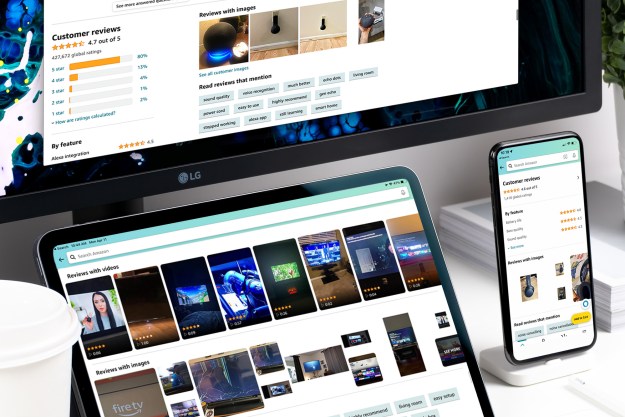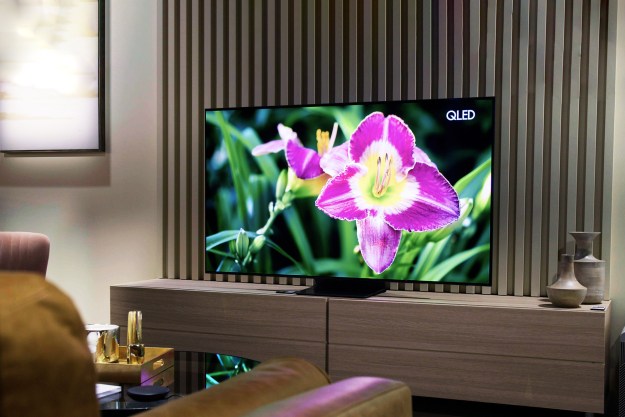- Very affordable for a large TV; integrated cable guide; average black levels
- Only one HDMI input; colors are not as vibrant as they should be; needs more inputs
If TVs get any larger, I may have to get a new house. It isn’t that the RCA Scenium HD61LPW175 DLP TV had any problem slipping through the front door for this review. After the delivery guys undressed it on my front deck, it was smooth sailing carrying the 18-inch deep TV through the door frame. And at about 90 pounds it was a fairly pain-free setup for them (easy for me to say) compared with the girth of a big-screen CRT.
It’s the viewing distance required that’s bumping me against the wall. I had to position myself at the very back of the room because anything closer to the screen was too close for comfort. I’m one of those people who prefers the back of the theater to the front, and trust me, a 61-inch TV can put on a heck of a show from 16 feet away.
Design and Features
The HD61LPW175 puts the wide in widescreen, to say the least. At 63 inches across (horizontal rather than diagonal the way screens are measured), the frame makes the TV look wider than most HDTVs because the 4.25-inch-wide speakers flanking the screen add an extra 8 ½ inches to the width. For someone trying to fit a TV into a cabinet the dimensions could be a problem, but the widebody TV comes with a pedestal base that fits easily on a table. Fortunately the black frame minimizes the overall look of the TV which makes an attractive presentation for a TV of its size.
The feature set of the HD61LPW175 covers the basics with CableCard and one HDMI jack. The HDMI input is one of five total inputs, including three back panel jacks (two component/S-Video and one composite) and a side-mounted composite A/V set. A side-mount mini headphone jack is included too. The side-mount input is convenient for plugging in game players and camcorders but it’s composite only, which won’t do much good for DV camcorder users or PS2 players who want to get the most out of their hardware. At the least, S-Video and USB jacks would be nice adds.
Additional jacks include A/V outputs, including digital audio, for recording to a hard-disk recorder or VCR. RCA tucked a G-Link cable into the accessory pack, which packs a mini plug on one end and IR emitters on the other for connection to a cable box/satellite receiver and video recorders. G-Link helps make the most of the TV Guide on Screen function that’s also part of the feature palette.
The TVGOS electronic program guide gives the program listings for your Zip Code for either cable or antenna. The colorful grid-based guide helps you schedule recordings; search for programs by category such as sports, movies or HDTV; and set reminders for programs you want to see later.
The RCA TV can display Emergency Alert System (AES) data, although the feature only works with TVs actively using the CableCard feature. That means the cable company has to send through the EAS information which typically includes flash flood, severe thunderstorm and tornado warnings. In the 2006 season of nasty tornadoes, the feature holds appeal but the limited compatibility reduces its effectiveness.
Image Courtesy of RCA
Setup and Use
If you have an aversion to owner’s manuals, this one from RCA may change your mind. The manual reads like the history of TV on one hand and a dummy’s guide to digital TV on the other. It’s both an interesting read and a valuable tool. The introduction includes an explanation of NTSC and ATSC television (I didn’t know widescreen movies came about in the 1950s as a way to lure consumers away from their TVs and back to the movie house).
The real strength of the manual is its explanation of TV features and terms and a guide to what you need to accomplish your goals. If you plan to use the CableCard, for instance, the manual bullet points what you need: a coaxial cable, digital cable subscription and CableCard. The next section spells out what you need to know about CableCard in general.
The connection section is similarly straightforward in describing the cables needed for the various inputs on the TV. That’s a great primer for the tech novice who has to make sense of composite, S-Video, component, HDMI and DVI. There are detailed explanations of parental control ratings, the menu system and TV Guide On Screen, too. This manual is a refreshing departure from poorly translated manuals that often leave users in the dark.
The straightforward setup process for TV Guide On Screen was simple to follow but the guide never downloaded overnight as promised after two attempts. A channel search indicated that the TV was able to receive the digital broadcast from the local broadcast stations but not the analog broadcasts. According to RCA, guide info is sent through the analog data stream from one of the major networks: CBS, ABC, NBC or PBS. I was able to receive the digital signal from all of the networks but not all of the analog signals so the guide information didn’t come through. It would appear that the problem is in the reception, not in the Guide software itself.
On-screen menus go beyond the norm, detailing what individual settings mean to help you choose between, say, widescreen and zoom in the aspect ratio menu. TV icons give a graphical representation of what happens to the image when you choose the various aspect ratios. You can see how the image stretches or how black bars appear when displaying 4:3 material–another helpful tool. I only wish the aspect ratio were available straight from the remote. You have to drill down into several menus to get to it.
Overall, though, the menus are very easy to use and self-explanatory. HDTV vets will appreciate their thoroughness, and newbies will appreciate the handholding.
Performance
I positioned the HD61LPW175 next to my four-year-old rear-projection CRT, and wow, what a difference in clarity! The CRT has served me well but this experiment has whetted my appetite for the crisp detail of Texas Instruments’ Digital Light Processing (DLP) technology. The HD61LPW175 proved to be a worthy display for what Phil Mickelson put on at Augusta during the 2006 Masters golf tournament.
The TVs shared a feed from my rooftop antenna, which a splitter divvied up between the two sets. Despite having the same source, the TVs looked so different on graphics and text that it looked like they were displaying different fonts altogether. The text on the HD61LPW175 was much easier on the eyes, from the names printed on the backs of the caddies’ shirts to the names and scores listed on the leader board. As consumers add Internet surfing to their TV experience over the next few years, accurate and very readable text rendering like that of the HD61LPW175 will become more and more important.
I was a bit underwhelmed by the color saturation of the RCA set on both broadcast TV and DVDs. The Incredibles didn’t pop off the screen as I had hoped they would. And I was expecting an explosion of color coming from the lush azaleas on the 13th hole at Augusta but found them somewhat subdued, although I could discern each flower. To the right, my CRT delivered more vibrant color but less detail. The perfect TV of my imagination does both. And where my CRT seems to lean toward the reds, the HD61LPW175 leans toward green. The set has a “green stretch” setting if you want to boost the greens, but even in the Off setting, I found a green cast that was particularly evident on cement and stone and in the white portions of black-and-white program material.
Black level was very respectable. Most TVs I’ve seen could improve on the detail within the blacks, and the HD61LPW175 was no exception. But I found the black level of the HD61LPW175 beat that of my CRT and most LCD TVs I’ve seen.
The HD61LPW175 offers six picture quality settings: vibrant, natural, cinematic, videogame, professional and the customizable personal setting. I tried using the cinematic setting when watching CSI but the images were too dark in the low-light scenes. In my sunny great room, only the bright setting of the display was truly bright enough for enjoyable viewing, even at night. Watching that cranked-up level full time would adversely affect the life of the lamp inside, though. To help conserve light life, the lamp power menu gives you a choice between longer life and brighter picture.
A step-down sequence at shut off gradually powers down the high-intensity lamp to preserve lamp life, which is no small consideration since I located a replacement bulb for this TV from a web-based service center for about $240. The sequence also serves a child- or pet-protection function as well. If the power button is hit unintentionally, the TV can be powered back up immediately without warm-up.
Conclusion
The HD61LPW175 lists for $3,099 but I found it on the web for as low as $2,148 and as high as $2,696. At the lower end of the price scale it makes a great buy considering the 61-inch screen size, picture quality, feature set and the comprehensive owner’s manual and menus.
Camcorder and video game users might feel shortchanged and inconvenienced by the low-end composite connectors on the side of the TV, and lamp life could be an issue if your viewing tastes lean toward the bright side. But picture detail is terrific and graphics are very clear. The HD61LPW175 delivers a very satisfying picture.
Pros
- Very affordable for a large TV
- Integrated cable guide
- Average black levels
Cons
- Only one HDMI input
- Colors are not as vibrant as they should be
- Needs more inputs
Editors' Recommendations
- What is 4K? Everything you need to know about 4K Ultra HD
- Samsung S95C OLED hands-on review: it’s time to get excited
- AptX Adaptive vs. aptX HD vs. LDAC: Which Bluetooth codec is the best?
- Sonos Voice Control hands-off review: Now we’re talking
- All the new tech that blew our reviewers away this month



